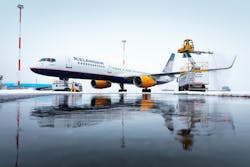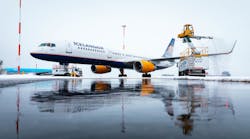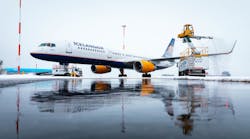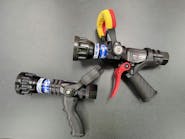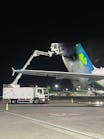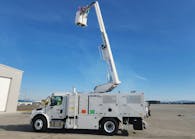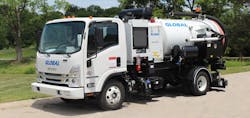Representatives at Vestergaard Company have identified a demand for electric-powered ground support equipment (eGSE) across the globe.
Lars Barsoe, vice president of sales and marketing at Vestergaard, says the demand for eGSE is driven by the appeal of reduced emissions and, as a result, a smaller environmental footprint. What’s more, exhaust from diesel engines powering deicers has been a focal point at many airports, particularly where aircraft are deiced at the gate, as space is often cramped and the fumes are not easily dissipated.
“We have seen a demand from airports and authorities around the world to move towards electric solutions,” Barsoe says.
In response, Vestergaard has developed its Elephant BETA Hybrid deicer – part of a company-wide drive to produce GSE powered by alternative energy sources.
“In general, Vestergaard Company’s vision is to have fully fossil-free ground support solutions by 2030,” Barsoe says.
The company’s flagship Elephant BETA deicer has been manufactured in a hybrid version since 2019.
The hybrid version of the deicer is still in an initial phase, Barsoe points out, adding numerous tests and are being conducted to receive necessary certifications.
“The first two units are being tested thoroughly in Scandinavia and Canada,” he adds. “Subsequently, the following units are for sale worldwide.”
The current hybrid version allows the unit to be driven with the chassis diesel engine to the deicing area – either at the gate or a remote location. Once at the deicing location, the diesel engine can be switched off and all deicing operations, including maneuvering around the aircraft, can be accomplished using exclusively battery-power.
Operating without the engine running helps eliminate pollution and reduce noise.
“The Elephant BETA Hybrid can service all types of aircraft and is particularly well-suited to engines-running deicing,” Barsoe says.
With a fully charged battery, the hybrid unit can deice approximately 15-20 aircraft without running the truck’s chassis engine. Fluid is heated with diesel in the current version, however, as soon as the desired temperature is reached, the heater turns off. With the heater off, the temperature drop is only about 1 degree Celsius per hour, according to company officials.
Presently, Vestergaard is producing the Elephant BETA Hybrid deicer with a fully enclosed cab.
“We will, however, in the not-so-distant future launch an open-basket, fully-electric deicer also,” notes Barsoe.
The units follow the standard Elephant BETA program, he adds, so the same options are available to customers who opt for the hybrid model.
“The Elephant BETA hybrid is of course equipped with collision-avoiding solutions – both on the chassis and on the telescope, and there are a number of camera-options available also,” Barsoe says. “The Elephant BETA is, from the outset, designed to be able to maintain a safe distance to the aircraft while still putting the nozzle within 1 meter of the surface.”
According to Barsoe, charging is always a critical question when a GSE manufacturer introduces an electric or hybrid model.
“The Elephant BETA Hybrid has an on-board charger, which can be plugged in almost everywhere,” Barsoe says, adding there are also a number of battery-capacity options. “The units are delivered with lithium-ion batteries and battery management system, which is simple to use and virtually maintenance-free.”
To improve charging times, he says fast-chargers can be utilized in the operations areas.
Barsoe points out the Elephant BETA Hybrid is a first step in the direction of fully fossil-free solutions for Vestergaard.
“It is possible to use synthetic diesel for heaters and also for the chassis engine, which is a solution by some customers to jump straight into the fossil-free new world,” he says.
When preparing to make a decision regarding deicing equipment, Barsoe stresses the importance of considering what type of deicing operations will take place. Is the deicing operation remote or performed at the gate? Is it a one-man or two-man operation? Will the operation utilize proportional mixing or pre-mixing?
Other considerations include capacity needed, time desired, availability of maintenance staff, availability of trained personnel, distance to filling stations and the time required to refill and reheat. Also, in the case of hybrid or electric solutions, access to charging must be considered.
“In general, the closer you can place the nozzle to the aircraft surface, the less amount of fluids are required for deicing, so it is important to choose/spec units that have enough reach and design to do just that,” Barsoe explains. “Also, it is important to spec mixing systems that take into account the outside air temperature to minimize the amount of glycol needed to mix into your hot water. Also, specify expected up-time and cost of yearly maintenance.
“For all customers, it is important to consider what the lifetime of the equipment will be and, thus, also possible resale value after specified periods,” Barsoe says. “With all those considerations, you arrive at a total cost of operation, which should be the overall deciding factor.”
